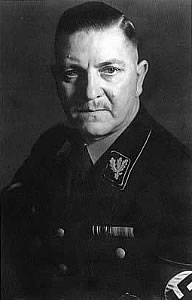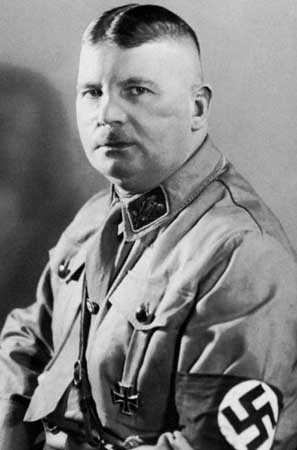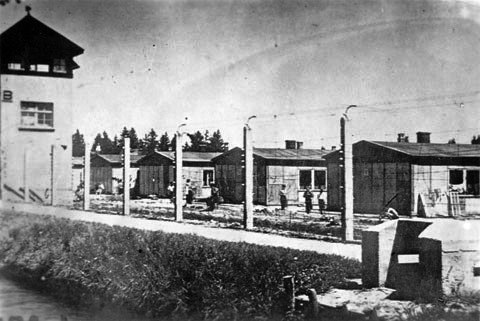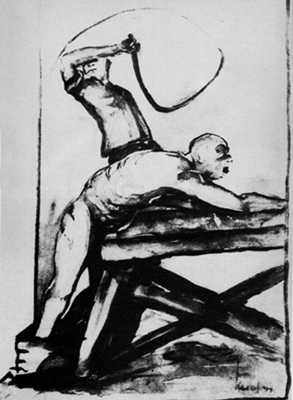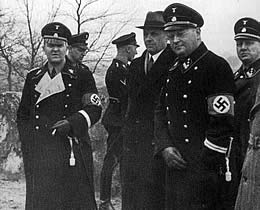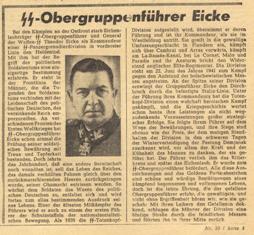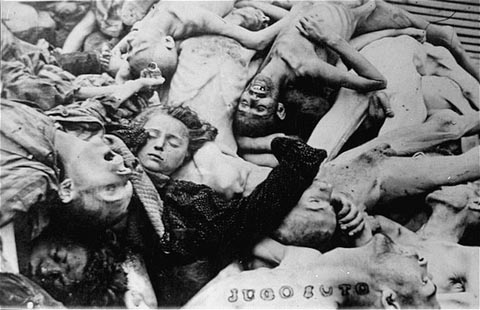Holocaust Education & Archive Research Team |
|
Other Camps
Key Nazi personalities in the Camp System The Labor & Extermination Camps
Auschwitz/Birkenau Jasenovac Klooga Majdanek Plaszow The Labor Camps
Trawniki
Concentration Camps
Transit Camps | ||||
Theodor Eicke "Papa Eicke" of the Concentration Camps
Theodor Eicke was born in Hudingen Alsace- Lorraine on 17 October 1892, the son of a station-master. He was discharged from the Imperial army after reaching the rank of sub-paymaster and being decorated with the Iron Cross (Second Class).
Eicke joined the police administration in Thuringia after qualifying as an inspector in 1920, he was briefly employed by the security police and the criminal police and by the police administration in Ludwigshafen on the Rhine.
He lost various jobs because of his anti-republican political activities, but in 1923 he was hired as a commercial executive by I.G. Farben (Ludwigshafen), also looking after their anti-espionage service.
Eicke joined the Nazi Party and the SA on 1 December 1928 and was transferred to the SS on 20 August 1930 where he was quickly promoted. Appointed SS-Standartenfuhrer on 15 November 1931, he was put in charge of the SS regiment in the Rhine-Palatinate.
Sentenced to two years’ penal servitude in March 1932 for political bomb attacks, he fled to Italy on Himmler’s instructions, returning to Germany in mid-February 1933.
The aggressive, restless Eicke soon clashed, however, with the Gauleiter of the Rhine- Palatinate, Josef Burckel, who declared him a “dangerous lunatic,” ordering his detention at the Psychiatric Clinic in Wurzburg on 21 March 1933.
Eicke was struck off the SS rolls, but reconfirmed in his old rank on 26 June 1933 and promptly appointed by Himmler as the new commandant of the Dachau concentration camp.
In May 1934 he was entrusted by the SS leader with the take-over of the concentration camps by the SS and with their re-organisation. On 4 July 1934 Eicke was appointed as Inspekteur der Konzentrationslager und SS- Wachverbande and a week later he was promoted to SS-Gruppenfuhrer.
The brutal, energetic Eicke had earned his promotion by his important role in suppressing the so-called Rohm putsch; it was Eicke who personally executed the SA chief in his cell at Stadelheim prison, in Munich on 1 July 1934.
In his new role Eicke proved to be a dedicated servant of Himmler and Heydrich, replacing the policemen who acted as guards at Dachau, by SS Death’s Head formations, the toughest and most ruthless troops that the Nazis possessed.
Under Eicke’s regime no pity was to be shown for “enemies of the state” and prisoners were treated with maximum severity. Eicke laid down exact instructions on corporal punishment, beatings, solitary confinement and shooting of offenders who were considered as “agitators,” mutineers or refractory elements who refused to obey instructions regarding working details.
Dachau was with its SS motto that “tolerance is a sign of weakness,” became a model for the German concentration camp system as a whole.
Rudolf Hoess who served at Dachau, and was later the Commandant at Auschwitz recalled his training at Dachau given by Eicke:
“The purpose of Eicke’s everlasting lectures and orders to the same effect was to turn his SS men completely against the prisoners, to stir up their feelings against the prisoners.”
Eicke’s writing paper bore the maxim “Only one thing matters – the command given,” and he warned his SS guard of severe penalties for any trace of softness. Eicke saw his task in terms of establishing a military discipline in accordance with SS ideals of “loyalty, bravery and devotion to duty,” telling his concentration camp commanders in 1939 “that they must be ready to carry out even the hardest and most difficult of orders without hesitation.”
On 14 November 1939 he was appointed Commander of the first SS-Totenkopf Division which he constituted in Dachau and took over the organisation and employment of the SS Death’s Head Formation which saw active service in Poland.
The Totenkopf division took part in the French campaign, first in northern France, at Arras, La Bassee –channel, Bethune, Bailleul, Loire, Lyon and Charente. Subsequent to the Armistice, it served as part of the occupation forces in France until April / May 1941.
In the war against the Soviet Union, the Totenkopf Division advanced through the Baltic States, liberating them from Russian occupation and proceeding to Lake Ilmen.
On 26 February 1943, Eicke was on an inspection flight in a Fiesler Storch when his plane was shot down by the Soviets near Orelka, Russia, and the plane crashed behind Soviet lines.
Several attempts were made by reinforced assault squads to recover the remains of their commander, they finally succeeded. after losing several men. Eicke was given an elaborate funeral at one of the cemeteries of the Division near Orelka.
In a manner reminiscent of the funeral rites performed by the ancient Germans upon the death of their tribesmen or kings, Theodor Eicke, or “Papa Eicke” as his troops called him, was laid to rest.
Later, when the Germans were forced to withdraw, officers from the divisional staff together, with a few selected men, exhumed Eicke’s corpse and brought it by truck to Kiev.
Who’s Who in Nazi Germany by Robert S Wistrich published by Routledge, London and New York 1995. Their Honour Was Loyalty by Jost W Schneider, published by R. James Bender Publications 1993. NARA
|
